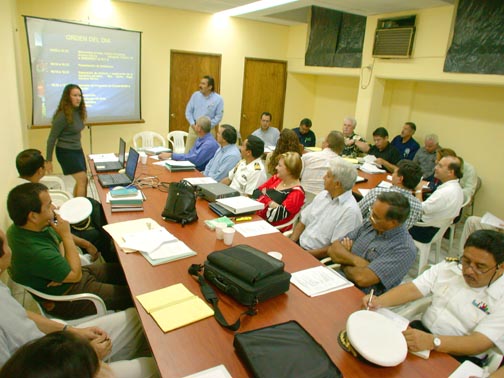
Revillagigedo Islands Fishing in Focus
![]()
|
MEETING IN LA PAZ--Representatives of the Sportfishing Association of California (SAC) were present at the initial public comment meeting for the Revillagigedos Islands Draft Management Plan, held at the La Paz, Baja California Sur, Mexico, offices of SEMARNAT, the Federal Department of Natural Resources, on Jan. 31, 2003. |
LITTLE PROMISE SEEN FOR RESUMPTION OF SPORTFISHING
AT MEXICO'S REVILLAGIGEDO ISLANDS
By Gene Kira, Feb. 3, 2003, as orginally published in Western Outdoor News:
Last Friday, four-dozen people jammed into a sweltering room in La Paz, Baja California Sur, Mexico, for a marathon, eight-hour, first public forum on Mexican federal government's Revillagigedo Islands Biosphere Reserve draft management plan.
This crucial meeting was attended by representatives of the Sportfishing Association of California (SAC), who were there to argue SAC's need to resume sport fishing at the islands. As I sat there, hour after hour, several key points gradually percolated to the surface.
First: Even though SAC's problems are in the forefront of our minds, San Diego's long range boats are so far off the radar screen in Mexico City they are hardly even visible. To put things into perspective, at the same moment this meeting was occurring, Agriculture Secretary Javier Usabiaga (also responsible for fisheries) was dealing with 50,000 campesinos almost rioting in Mexico City over what NAFTA is doing to the economy and their way of life. As he watched this fantastic anti-government rally on television, somehow, I don't think Usabiaga was concentrating very much on the Revillagigedo Islands sportfishing problem, or the Mexican sportfishing industry in general.
|
|
(The draft management plan itself, comprised of some 140 tightly-phrased pages, devotes only a few ambiguous lines to the subject of sportfishing.)
Second: It seemed irrelevant to the plan's creators whether giant yellowfin tuna are highly migratory or not. The international concept of the Biosphere Reserve is give all species that occur within them a safe zone, even if they only visit two weeks per year. This is analogous to localized methods of protecting wandering species such as monarch butterflies, gray whales, etc.
Third: There seems to be little political space in Mexico City for allowing any kind of fishing boats--sport or commercial--to circumvent LGEEPA, the basic environmental legislation governing Mexico's natural protected areas. LGEEPA states flat-out that no extractive use may be made of a Biosphere Reserve's Nucleus Zones. At the Revillagigedos, that means six nautical miles out from each island.
Underscoring that point at the meeting were statements by PROFEPA and a commercial fishing representative, who reiterated the fact that yellowfin tuna are not reserved only for sport fishing. Therefore, if sport boats are allowed to reenter the islands, logically, commercial boats should be permitted as well.
At the La Paz meeting, there was zero--and I mean ZERO--official enthusiasm for any such circumvention or "creative" interpretation of LGEEPA. One top source said recently that even President Fox could not, at this point, order a recreational fishing permit for the islands; the political fallout would be like stomping on a hornet's nest.
On the other hand, representatives of CICIMAR, a La Paz marine research institute, concluded at the meeting that the entire draft management plan is basically a piece of junk.
|
|
One biologist afterward confirmed my impression that whoever drew the polygons defining the protected zones around the islands must have done it by first throwing darts at the charts and then connecting the dots. The boundaries of the Nucleus and Buffer Zones do not seem to follow biological guidelines. Why should the Nucleus Zones (where fishing is absolutely prohibited) extend exactly six miles out from the islands? Why not sixty feet? Six-hundred cubits? There seems to be no scientific reasoning behind the process.
This leads naturally to an intriguing idea that seemed to be overlooked at the meeting. Could the islands be studied, and the Nucleus Zone boundaries be redrawn according to scientific guidelines?
If enough information were made available, perhaps a much more sophisticated and complex protection scheme could be implemented, one that would allow select types of activities (such as careful sport fishing, but not commercial fishing) much closer to the islands than at present. In other words, perhaps the totally prohibited Nucleus Zones don't really need to be six miles wide.
Furthermore, perhaps SAC could be grandfathered into the Biosphere Reserve as "remote" residents, just as the people of San Felipe and Puerto Penasco were allowed into the Alto Golfo Biosphere Reserve. That would allow SAC to fish in the newly-defined Buffer Zones.
These kinds of changes would require the proverbial "act of Congress," following a two to three-year study by dozens of biologists. Also required would be some sophisticated lobbying in Mexico City of a kind that hasn't been tried so far. That's a lot of work, but it may be the most practical hope for reentry to the islands.
(Related Mexico articles and reports may be found at Mexfish.com's main Mexico information page. See weekly fishing news, photos, and reports from the major sportfishing vacation areas of Mexico including the Mexico area in "Mexico Fishing News.")
MEXICO FISHING INFO MEXICO FISHING INFO "WEEKLY MEXICO FISHING NEWS" FISH PHOTO GALLERY
